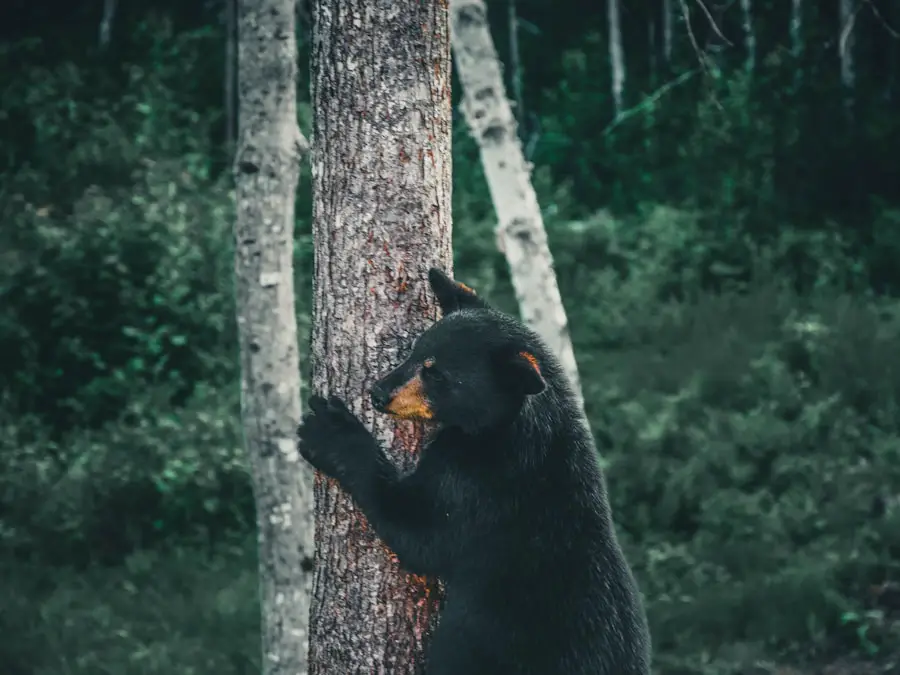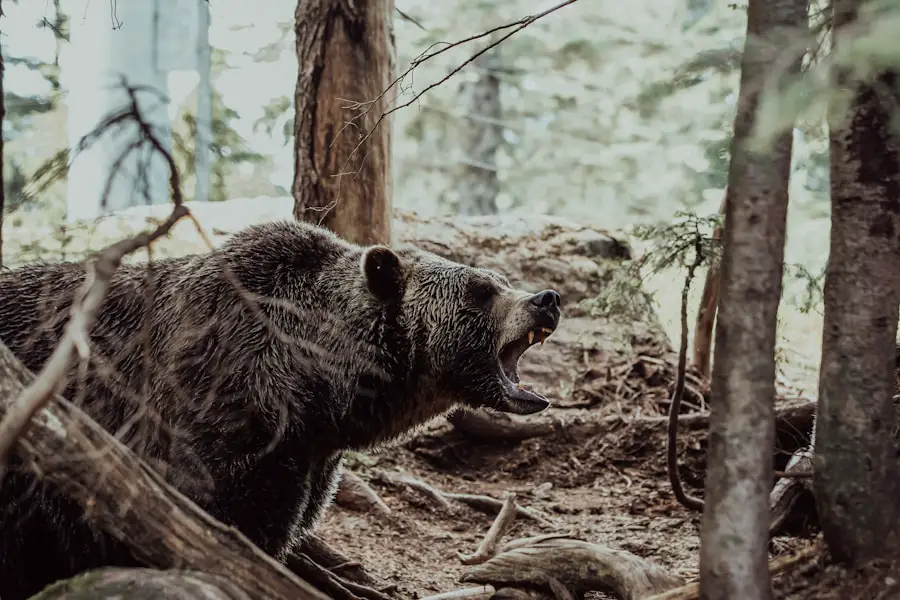Bears are complex creatures with behaviors that can be both fascinating and intimidating. Understanding their behavior is crucial for anyone venturing into bear country, as it can significantly reduce the risk of an encounter. Bears are generally solitary animals, except during mating season or when a mother is raising her cubs.
They exhibit a range of behaviors that can indicate their mood or intentions. For instance, a bear that is foraging for food may appear calm and focused, while a bear that feels threatened may stand on its hind legs to get a better view or sniff the air to assess the situation. This behavior is not necessarily aggressive; it is often a sign of curiosity or caution.
Bears are also highly intelligent and adaptable animals. They have excellent memories and can remember the locations of food sources for years. This adaptability means that they can learn to associate humans with food, especially if they have had previous encounters where food was readily available.
This learned behavior can lead to more frequent bear sightings in areas where people camp or hike, as bears become accustomed to human presence. Understanding these behavioral patterns is essential for minimizing risks and ensuring both human safety and bear conservation.
Key Takeaways
- Bears are generally shy and avoid humans, but understanding their behavior can help hikers avoid encounters.
- Proper food handling and storage is crucial to prevent attracting bears to your campsite.
- Making noise on the trail can alert bears to your presence and prevent surprising them.
- Carrying bear spray and knowing how to use it can be a lifesaving tool in a bear encounter.
- Keeping a clean campsite and properly disposing of waste can help prevent attracting bears to your area.
Proper Food Handling and Storage
One of the most critical aspects of preventing bear encounters is proper food handling and storage. Bears have an extraordinary sense of smell, which can detect food from miles away. Therefore, it is vital to store food securely when camping or hiking in bear territory.
The best practice is to use bear-proof containers or canisters specifically designed to keep bears out. These containers are often made from durable materials that bears cannot easily break into, providing an effective barrier between your food and curious bears. In addition to using bear-proof containers, it is essential to practice good food hygiene while cooking and eating outdoors.
This includes cooking away from your sleeping area, cleaning up thoroughly after meals, and disposing of waste properly. Leftover food scraps should be packed out or disposed of in designated bear-proof trash bins if available. Even items like toothpaste or scented toiletries can attract bears, so storing these in bear-proof containers is equally important.
By taking these precautions, you significantly reduce the likelihood of attracting bears to your campsite.
Making Noise on the Trail

When hiking in bear country, making noise is an effective strategy to alert bears to your presence and reduce the chances of surprising them. Bears are generally shy animals that prefer to avoid human interaction; however, they may not hear you approaching if you are quiet. Making noise can be as simple as talking with your hiking companions, clapping your hands, or using a bear bell attached to your backpack.
The sound will travel through the forest, giving bears ample warning to move away from the trail. In addition to making noise, it is advisable to stay in groups while hiking. Bears are less likely to approach larger groups of people due to the increased noise and activity levels.
If you are hiking alone, consider singing or whistling periodically to ensure that any nearby bears are aware of your presence. This proactive approach not only enhances your safety but also contributes to a more enjoyable hiking experience by fostering a sense of camaraderie among fellow hikers.
Carrying Bear Spray
| Year | Number of Bear Spray Uses | Number of Bear Attacks |
|---|---|---|
| 2018 | 50 | 12 |
| 2019 | 65 | 15 |
| 2020 | 72 | 18 |
Carrying bear spray is an essential safety measure for anyone exploring bear habitats. Bear spray is a type of pepper spray specifically formulated to deter aggressive bears during an encounter. It contains capsaicin, the active ingredient that causes the burning sensation in peppers, which irritates a bear’s eyes and respiratory system, causing it to retreat.
When choosing bear spray, look for products that have a minimum concentration of 1% capsaicin and a range of at least 30 feet for effective use. Knowing how to use bear spray properly is just as important as carrying it. It should be easily accessible, ideally stored in a holster on your hip or chest rather than buried in your backpack.
In the event of a bear encounter, aim for the bear’s face and deploy the spray when the bear is within 30 feet. It’s crucial to practice using the spray in a safe environment before heading into the wilderness so that you feel confident in your ability to respond quickly if needed. Bear spray has proven effective in deterring aggressive bears in numerous encounters, making it an invaluable tool for outdoor enthusiasts.
Keeping a Clean Campsite
Maintaining a clean campsite is one of the most effective ways to prevent attracting bears and other wildlife. A clean campsite minimizes odors that could lure bears into your area, reducing the likelihood of an encounter. Start by setting up your cooking area away from your sleeping quarters and any food storage areas.
This separation helps contain any food smells and keeps your sleeping area less appealing to bears. After cooking, ensure that all dishes are washed promptly and stored away securely. Food scraps should be packed out or disposed of in designated trash receptacles if available.
Even items like cooking utensils and coolers should be cleaned thoroughly after use, as they can retain food odors that attract bears. Additionally, consider using unscented soap for washing dishes and personal items while camping. By adhering to these practices, you create an environment that discourages bears from approaching your campsite.
Choosing the Right Hiking Gear

Selecting appropriate hiking gear is essential for safety and comfort when exploring bear country. Sturdy footwear with good traction is crucial for navigating uneven terrain and ensuring stability on trails where bears may be present. Hiking boots should provide ankle support and be waterproof to protect against wet conditions often found in bear habitats.
In addition to footwear, wearing bright colors or patterns can help make you more visible on the trail, which may deter bears from approaching you out of curiosity. Lightweight clothing made from moisture-wicking materials will keep you comfortable during long hikes while also allowing for ease of movement. A well-fitted backpack with adjustable straps will help distribute weight evenly across your body, reducing fatigue during extended hikes.
Investing in quality gear not only enhances your hiking experience but also contributes to your overall safety in bear territory.
Recognizing Bear Signs
Being able to recognize signs of bear activity is crucial for staying safe while hiking or camping in bear country. Common signs include paw prints, claw marks on trees, scat (bear droppings), and overturned rocks or logs where bears have been foraging for insects or roots. Paw prints can vary depending on the species; black bears typically have rounder prints with five toes, while grizzly bear prints are larger with distinct claw marks.
Additionally, observing signs of recent bear activity can help you gauge how close you might be to a bear’s territory. Fresh scat will appear moist and dark, while older scat will dry out and lose its shape over time. If you notice signs of active bear presence along your trail or near your campsite, it may be wise to alter your route or take extra precautions such as making more noise or moving to a different location altogether.
Knowing What to Do in a Bear Encounter
In the event of a bear encounter, knowing how to react can make all the difference in ensuring your safety. If you spot a bear at a distance, remain calm and avoid sudden movements; instead, slowly back away while keeping an eye on the bear without making direct eye contact, which could be perceived as a threat. If the bear approaches you, stand your ground and do not run; running may trigger a chase response in the bear.
If a bear charges at you, it may not necessarily mean an attack; often, bears will bluff charge as a way to assert dominance or scare off perceived threats. In such cases, continue standing firm and prepare to use your bear spray if the bear comes within range. If a bear does make contact with you, playing dead may be effective if it’s a grizzly bear; however, if it’s a black bear, fighting back with any available objects may be necessary as they tend to be more aggressive in confrontations.
Understanding these behaviors and responses can significantly enhance your safety while enjoying the great outdoors in areas inhabited by bears. By being prepared and knowledgeable about how to coexist with these magnificent creatures, you contribute not only to your own safety but also to the preservation of wildlife habitats for future generations.
When hiking in bear country, it’s important to know how to scare a bear away if you encounter one. One helpful article on this topic can be found at TakeTravelInfo. This article provides valuable tips and techniques for safely deterring bears while out on the trails. Remember, being prepared and knowing how to react in a bear encounter can make all the difference in staying safe during your outdoor adventures.
FAQs
What should I do if I encounter a bear while hiking?
If you encounter a bear while hiking, it’s important to remain calm and slowly back away while facing the bear. Do not run or make sudden movements, and do not approach the bear.
How can I scare a bear away while hiking?
To scare a bear away while hiking, you can make loud noises by shouting, clapping, or using a whistle. You can also try to make yourself appear larger by raising your arms or waving an object like a jacket or backpack.
Should I use bear spray to scare away a bear while hiking?
Bear spray can be an effective deterrent for bears while hiking. If you have bear spray, follow the instructions on the canister and use it if the bear approaches too closely. Be sure to aim for the bear’s face and continue to back away slowly.
What should I do if a bear charges at me while hiking?
If a bear charges at you while hiking, stand your ground and continue to make loud noises. If the bear makes physical contact, play dead by lying on your stomach with your hands clasped behind your neck and legs spread apart to make it harder for the bear to flip you over.
Are there any preventative measures to avoid encountering bears while hiking?
To avoid encountering bears while hiking, make noise while on the trail to alert bears of your presence, travel in groups, and be aware of your surroundings. Additionally, be sure to properly store food and dispose of waste to avoid attracting bears to your campsite.
